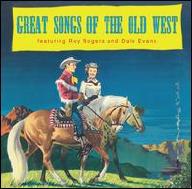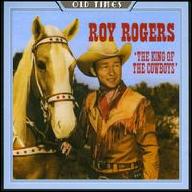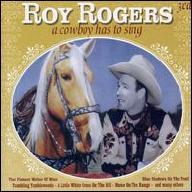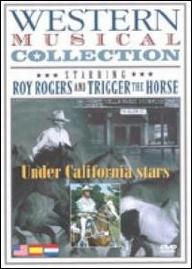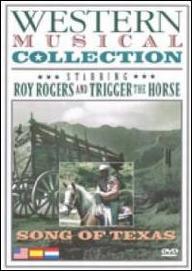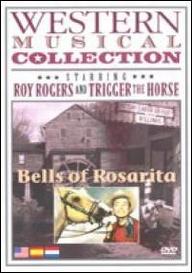He was born in Cincinnati, OH, the son of Andrew and Mattie Womack Slye. The entire household was musical, and by the time he was a teenager, Len could play the guitar and the mandolin. Although he later took on the role of a cowboy before the public, the closest he got to riding the range was working the family farm they had in a small town outside of Cincinnati. By age 19, he'd headed out to California, where chance led him to enter an amateur singing contest on the radio, resulting in an offer to join the Rocky Mountaineers. There he made the acquaintance of Bob Nolan. They developed a harmonious friendship that worked well within the group for several months, until Nolan exited in frustration over their lack of success. His replacement was Tim Spencer, and eventually Slye, Spencer, and another singer named Slumber Nichols quit the Rocky Mountaineers in the spring of 1932 to form a trio of their own, which never quite came off. Slye decided to push on, joining Jack LeFevre His Texas Outlaws.
In early 1933, he got Spencer and Nolan together to form what was then known as the Pioneer Trio. Their mix of singing and yodeling, coupled with their good spirits, won them a job on radio. Within a few weeks, they were developing a large following of their own on LeFevre's show, with their harmony singing eliciting lots of mail. A fourth member, fiddle player Hugh Farr, was added to firm up their sound early in 1934. The group's name was altered by accident -- on one broadcast the station's announcer introduced them as "The Sons of the Pioneers." The group sold large numbers of records from the very beginning, with the classic Nolan original Tumbling Tumbleweeds cut at their very first session. Two more new members, Lloyd Perryman and Hugh Farr's guitarist brother Karl, were added, and by the mid-'30s the sextet was one of the top-selling country acts, performing to sell-out audiences and sought by radio stations and sponsors eager to back them on the air.
During this period, Slye did occasional work as a movie extra and bit player in B-Westerns under the name Dick Weston at Republic Pictures, where the reigning king of Western movies was another singer, Gene Autry, whose records outsold even the Pioneers'. In 1938, Autry entered into a contractual dispute with Republic that resulted in his failure to report for his next movie. Republic, anticipating the dispute, had put out the word -- apparently more as a ploy than a real attempt at replacing their top male star -- that they were looking for a new leading actor for their Westerns. Slye tried sneaking onto the lot with a group of extras and was caught, but a sympathetic director permitted him to take a screen test. He tested extremely well and got the part. At the time, the Pioneers had just signed a contract with Columbia Pictures to appear in and play musical support to Charles Starrett in a series of B-Westerns, and he was forced to leave the group in order to sign his own contract at Republic.
A new name was required and "Roy Rogers" was selected, the "Rogers" coming from Will Rogers and "Roy" coming off of a list. He made his debut in #Under Western Stars; not only did it introduce Rogers as a new star, but also his horse, Trigger. A long-term contract followed, and for the next 13 years, he was one of the studio's mainstays, rivaling and later surpassing Autry at the box office. By 1940, Rogers was successful enough to approach Republic with a request for a salary increase. The studio was notoriously reticent on such matters, and he was denied any raise. But in lieu of the request, he extracted a much more valuable concession -- the rights to the name Roy Rogers and all merchandising that went with it. The early '40s saw Rogers turn into a national institution. His Westerns became even more popular and accessible once they were taken out of the "historic" West of the 19th century and moved into the modern West, which allowed for more freedom in plotting and dialogue. With director Joseph Kane helming his movies, Rogers became the undisputed "King of the Cowboys" after Autry joined the U.S. Army Air Force in 1942. By 1944, however, the movies and records represented only a small part of the success that Rogers had achieved. The merchandising of Rogers memorabilia and other items -- not just toys, but cereals and electric ranges -- coupled with a syndicated radio show made him one of the most familiar figures in popular culture throughout the war years.
In 1944, with his first teaming with featured actress Dale Evans, the next major element in his screen success was in place. Their relationship was, at first, purely professional, but their chemistry on screen was undeniable, and Republic was soon pairing them up regularly. With the return of master action director William Witney from service in the war during 1945, Rogers' film career was poised for success for years to come, as Witney toughened up the Rogers movies and elevated their action sequences. All of this success, and the whirlwind of activity surrounding it, was negated by the death of Rogers' wife, Arline, from an embolism following the birth of their son, Roy Jr., on November 3, 1946. Rogers continued making movies and recording, along with his personal appearances and radio broadcast. In the course of their work together in pictures, he and Evans (who had already been designated "The Queen of the West" by Republic's publicity office) became ever closer. Finally, on December 31, 1947, the two were married. They made movies together for the remainder of the 1940s, and when the market for B-Westerns began to disappear with the advent of television, Rogers followed the lead of Western star William (Hopalong Cassidy) Boyd and devised a television series of his own. #The Roy Rogers Show, starring Rogers and Evans and co-starring Roy's Pioneers replacement, Pat Brady, went on the air on NBC in December of 1951, beginning a seven-year network run that introduced his work to yet another generation of fans.
His first solo recordings featured backup by Hugh and Karl Farr and Bob Nolan, and the complete Pioneers supported him in most of his recording sessions for the remainder of 1937 and 1938. Later on, however, Rogers was backed by Spade Cooley His Buckle-Busters as well as various anonymous studio orchestras, although Karl Farr would turn up on his sessions as well into the 1940s. On record as a solo artist, Rogers was never as successful as the Pioneers or Autry, although he did have one promising early hit in 1938 with Hi-Yo Silver, which reached number 13 on the charts. Even Rogers' sessions on his own recordings with the Sons of the Pioneers, however, little resembled his earlier work as a member of the Pioneers, for his was now the lead voice. And where Bob Nolan and Tim Spencer (the principal songwriters within the group) never strayed too far from some contact with the reality of the West, Rogers' music quickly took on the aura of more typical Hollywood Western songs, pleasant but not generally profound. His covers of songs such as Don't Fence Me In are probably the best remembered versions, thanks to his movies, and as songs like San Fernando Valley or Home in Oklahoma reveal, he had an extremely appealing tenor voice, not as memorable as Autry's voice but very pleasing to the ear nonetheless. Perhaps the most well-known of all Rogers' songs was one written by Evans and (originally) recorded by them together, Happy Trails, which became the theme of #The Roy Rogers Show. From the 1950s onward, his repertory included country music as well as Western songs and spirituals, the latter often recorded with Evans.
Rogers continued to record into the 1970s, and he scored a hit in 1972 with Candy Kisses. He and Dale continued making personal appearances, often in the context of religious broadcasts and gatherings, as well as television broadcasts, into the early '90s. Rogers' main influence was in keeping the image of the singing cowboy alive. Along with Autry, who retired from personal appearances at the end of the 1950s, he was one of the most popular Western stars ever to record and was an influence on an entire generation of country western singers that followed. In 1988, Rogers was elected to the Country Music Hall of Fame, giving him a second spot (the first having come as a member of the Sons of the Pioneers, who had been elected some years earlier). Two years later, the next generation of country musicians, including Emmylou Harris and Randy Travis, participated in a most unusual record, The Roy Rogers Tribute, covering Rogers' best known songs with him, including an all-star rendition of Happy Trails. Two years later, Rogers, his wife, and eldest son recorded a new album of spiritual songs. Rogers died at his home in Victorville, CA, on July 6, 1998. ~ Bruce Eder, Rovi




